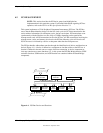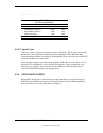
Chapter 4 System Support
Compaq Deskpro 4000N and 4000S Personal Computers
First Edition - September 1997
4-8
Table 4–5. PCI Device Identification
Table 4-5.
PCI Device Identification
PCI Device Vender ID Device ID
VT82C595 (North Bridge) 1106h 0595h
VT82C586 (South Bridge):
PCI/ISA Bridge (Function 0)
EIDE Controller (Function 1)
USB I/F (Function 2)
ACPI Cntlr (Function 3)
1106h
1106h
1106h
1106h
0586h
0571h
3038h
3040h
Network Interface Controller 0E11h B011h
Graphics Controller 5333h 8901h
4.2.3.3
Special Cycles
There are two types of special cycles that may occur on the PCI bus. The first type is initiated by
the host and is used to perform the following functions: Shutdown, Flush, Halt, Write Back,
Flush Acknowledge, Branch Trace Message, and Stop/Grant. These cycles start like all other PCI
cycles and terminate with a master abort.
The second type of special cycle is initiated by writing to 0CF8h, Bus # = all 0s, Device = all 1s,
Function # all 1s, and Register = all 0s) and 0CFCh to generate a Type 0 configuration cycle.
This type 0 cycle, however, does not assert any of the IDSEL lines and therefore results in a
master abort with FFFFh returned to the microprocessor.
4.2.4
OPTION ROM MAPPING
During POST, the PCI bus is scanned for devices that contain their own specific firmware in
ROM. Such option ROM data, if detected, is loaded into system memory’s DOS compatibility
area (refer to the system memory map shown in chapter 3).


















